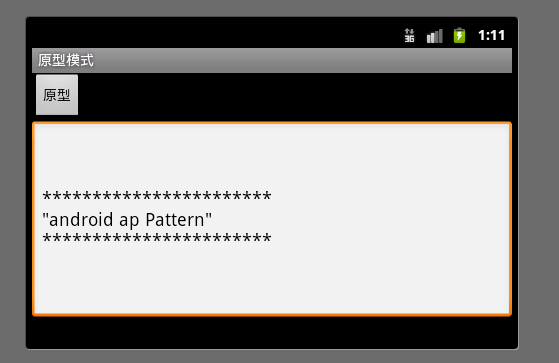Android Ap 开发 设计模式第六篇:原型模式
2011-07-14 21:26 Terry_龙 阅读(2560) 评论(2) 编辑 收藏 举报Prototype Pattern
名称由来
不是利用类来产生实例对象,而是从一个对象实例产生出另一个新的对象实例 ,根据被视为原型的对象实例 ,建立起的另一个新的对象实例就称为原型模式(Ptototype Pattern)。
需求场景
- 种类过多无法整合成类时
第一种情形:若须处理的对象种类太多,如果要一个个设成不同的类,须产生大量的源程序文件 - 不容易利用类产生对象实例时
第二种情形:该对象的实例产生过程太复杂,很难利用类来建立。 - 希望把框架和所产生的对象实例分开时
第三种情形:希望让产生对象实例时的框架不会只存在于某些特殊类时。
功能演示
测试程序类结构图如下:

模式UML图中,共有三个类:
- 接口,Product 己声明抽象方法use 和 createClone的接口
- 管理类,Manager 利用createClone 复制对象实例的类
- 普通类,MessageBox 把字符串框起来use 的类,实现Product的createClone 和use 方法。
Product 接口
public abstract String use(String s);
public abstract Product createClone();
}
有了Product 接口 ,才可能进行复制。这个接口继承java.lang.Cloneable 接口 ,利用clone 方法可自动对实现此接口 的类进行复制。
use 方法是“使用”的部分,“使用”代表何种意义则需看子类的实现。
createClone方法负责复制对象实例的部分。
Manager类
private Hashtable<String, Product> showCase = new Hashtable<String, Product>();
public void register(String name, Product proto) {
showCase.put(name, proto);
}
public Product create(String protoName) {
Product p = showCase.get(protoName);
return p.createClone();
}
}
唯一跟其他类沟通的桥梁,负责添加和负责对象的实例。
MessageBox类
private char decochar;
public MessageBox(char dechar) {
this.decochar = dechar;
}
@Override
public Product createClone() {
// TODO Auto-generated method stub
Product p = null;
try {
p = (Product) clone();
} catch (CloneNotSupportedException e) {
// TODO: handle exception
e.printStackTrace();
}
return p;
}
@Override
public String use(String s) {
// TODO Auto-generated method stub
int length = s.getBytes().length;
StringBuffer sb = new StringBuffer();
for (int i = 0; i < length + 4; i++) {
sb.append(decochar);
}
sb.append(decochar + "\n\"" + s + "\"\n" + decochar);
for (int i = 0; i < length + 4; i++) {
sb.append(decochar);
}
sb.append("");
return sb.toString();
}
}
createClone 方法是复制本身的方法,这里所调用的clone 方法规定在java 语言规格内,它会产生另一个分身(本身的复制品)。在产生复制品时,若该字段包含对象实例,则其值也会跟着复制到新的对象实例。能利用clone 方法进行复制的只限于实现java.lang.Cloneable 接口 的类。如无实现则会报异常。但MessageBox 本身实现了Product ,而Product 是己经继承了Cloneable接口。
Java 语言的clone 方法只能从本身的类(含子类)调用,所以如果是其他类的要求而进行复制时,则须另以其他方法(如createClone)把clone 抓起来。
android 界面入口测试该原型 Prototype 的PrototypeActivity
/** Called when the activity is first created. */
@Override
public void onCreate(Bundle savedInstanceState) {
super.onCreate(savedInstanceState);
setContentView(R.layout.main);
((Button) findViewById(R.id.Button01))
.setOnClickListener(new OnClickListener() {
@Override
public void onClick(View v) {
// TODO Auto-generated method stub
Manager manager = new Manager();
MessageBox messageBox = new MessageBox('*');
manager.register("prototype", messageBox);
Product product = manager.create("prototype");
((EditText) findViewById(R.id.EditText01))
.setText(product.use("android ap Pattern"));
}
});
}
}
运行效果如下:

源码下载:
再发个求职信息:
求职android(可胜任Framework及 以上工作。一年半经验) 、Windows Phone 7(软件、XNA) 开发工作。
